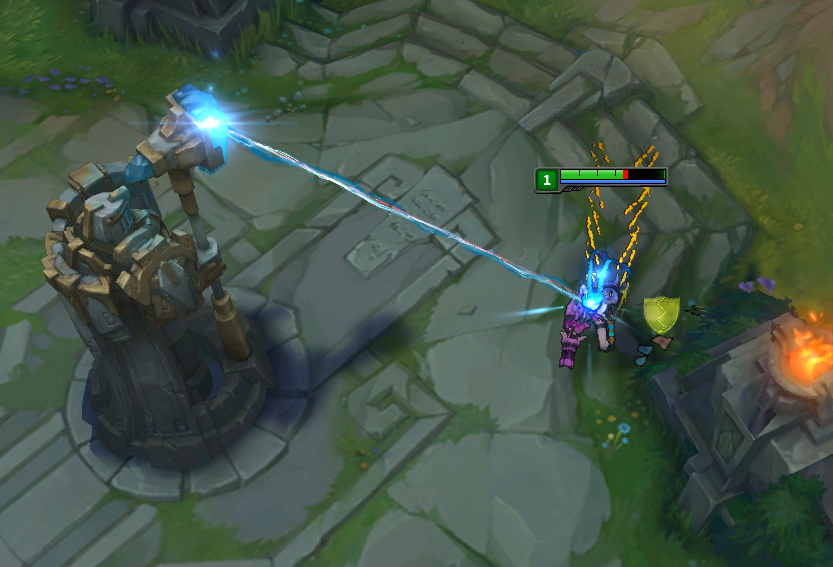I'm Going to Disney World!; On Rules, and How They Drive Emergent Gameplay
Our games are evolving and players are finding new ways to play. Emergent gameplay is wonderful, but sometimes it mucks up what we're trying to do as designers. So, how do we build games that foster emergence?

Colloquially known as "The Most Magical Place on Earth!" Walt Disney World is a modern day cultural icon. Though many recognize Disney World as a marvel in amusement park entertainment, game developers are very quick to recognize the park as a marvel of level design. With 52 million visitors annually, Disney World is the most traveled vacation resort in existence. Despite this traffic, anyone who is fortunate enough to visit the part today enjoys ergonomically sound guest flow, complete with a simple to navigate rail system and connecting pathways that flow through the park seamlessly.
Walt Disney ensured this would be the case, not only through his interest in urban planning, but his bizarre decision to open Disney Land in California 20 years earlier with no footpaths whatsoever. Guests were initially shocked and confused, as the park was fully functional. The rides ran, the vendors vended, and the place had all the magic and splendor you'd expect from Disney. It was great, except for the lack of paths. Regardless, guests enjoyed the park as best they could, meandering around in what made sense to them to reach their destinations. Ultimately, this is exactly what Disney intended. Walt kept paths out of Disney Land for an entire year, and then noted where the grass of the park was trampled. Come year two of Disney Land, paths were laid exactly where people had naturally progressed the year before. It seemed so foreign, but Walt Disney knew exactly what he was doing: he was creating paths organically; which he then brought to Disney World years later.
Another critical element of Disney World's park design: the Weenie
In a lot of ways emergence is simultaneously the best and worth things about our jobs as game designers. On the one hand emergent gameplay shows that our players are exploring and playing in the space that we've built for them, and doing so in such a way that they can develop new methods of play and interaction. On the other hand, emergent mechanics often times are the result of breaking a game, abusing a strategy, exploiting a fault, or bypassing natural progression blocks or skill checks in ways we as designers didn't predict. However much like Agent Smith in the Matrix, games we create are bound by concrete technical limitations, and thus some set of rules exist in every game made.
The relationship between emergent mechanics and rules is very simple, and it starts by looking at "actual rule" vs "implied rule". We'll start with actual rule, which is everything the player can do in the game. Regardless of what feature, mechanic, or menu option the player performs, so long as it can be performed in game without any sort of hacking or modding, it's an actual rule. It's important to recognize here that 'actual rule' doesn't always make sense. Running a deck in the Pokemon TCG with no energy cards is allowed under the umbrella of 'actual rule,' as is releasing your Pokemon in the videogames.
Implied rule is the mechanical and system oriented framework that we want our players to ultimately follow, or the 'correct' way to play the game. Going back to our Pokemon example the implied rule here is I keep every Pokemon I catch in the videogames, and I run energy cards in the card game. It's really important to emphasize here that implied rule IS NOT the same as 'meta.' Meta will of course come from the implied rule, but the implied rule is the framework underneath the meta, not the meta itself. Here's why these two types of rules are important: when players ignore implied rule and explore actual rule, emergent mechanics happen.

Probably the only mainstream instance we've ever seen of releasing a Pokemon
I fundamentally believe that All Ghillied Up is one of, if not the best, levels that has ever been crafted in videogames. A story driving mission in the wildly successful and popular Call of Duty 4: Modern Warfare, All Ghillied Up had players following Captain MacMillan through radiation torn Pripyat to assassinate a high profile target. Players donned "Ghilly suits" and followed a pathway leading up to a church, through an open field, across a junkyard, and finally traversed an abandoned village to perch up on the top floor of an office building to make the assassination. Needless to say, the mission is a stealth mission and Captain MacMillan gives you orders throughout the entire process. That's the implied rule at least.
The actual rule of All Ghillied Up is players are able to complete the mission in the same fashion they have every other mission: running and gunning and blowing stuff up and shooting everyone in sight. Even though Captain MacMillan is giving the player orders, those orders are not enforced. Players can ignore those orders at any time and go through the mission as they see fit. One of the most impactful moments in that level (played under the implied rule set) comes after the player exits the church and crosses the wide open field right as an enemy patrol approaches in what is an exceptionally tense moment. Players are moving mere inches as soldiers, helicopters, and tanks cross over them.
Now one would think this challenge would be impossible to overcome in the actual rule of 'going loud' but (of course) the church is a weapons stash for rocket launchers. Admittedly All Ghillied Up will lose a lot of it's charm and a lot of what makes it great if the player decides to 'go loud' but all of those avenues and choices for the player exist. When looking at All Ghillied Up, it's important to recognize the delicate balance between what is truly "emergent" and what is simply an alternate play style. Emergent gameplay as a whole is relatively open to interpretation, and depending on who you talk to you might get a few different answers and definitions. As much as I love All Ghillied Up, I don't think it's fair to call this emergent gameplay. Sure the player is exploring the actual rule of going loud, but logically speaking that opportunity is created for the player through deliberate level design choices.
In this regard, another important element of an emergent mechanic is not only the pursuit of actual rule, but also using this actual rule in ways that developers didn't anticipate. In Riot's game League of Legends, towers exist as a way of gating the player from the enemy base, and pacing out a league match. This gating is very simple: Towers shoot players, players are too weak early on to destroy towers, tower kills player. Actual rule here is a player will be shot and killed by a tower when they are all alone, and the implied rule is don't approach towers without minion cover or late game strength.
These rules seem very simple, and tower behavior is a closed enough gameplay mechanic that an opportunity for emergent gameplay is relatively challenging. Naturally, players managed to do just that. Another component of League of Legends is earning gold for killing your opponents, with champions that are doing well being worth more gold, and champions that are doing not so well being worth less gold. There is also another mechanic in that game where if a player dies to a tower, and no enemy champion has damaged them recently, they simply die and no one gets their gold bounty. This is a tactic in game known as suiciding.
What players discovered early on in League of Legends history is that the game didn't distinguish between a player kill or a suicide in counting deaths, so a player who had been killed 5 times had been killed 5 times, regardless of how many of these kills were opponent player kills vs suicides. And thus an emergent mechanic was born, one that saw players deliberately and intentionally suiciding to towers as soon as a game started to make sure they were not worth gold. At one point in League of Legends history, it wasn't uncommon to have several players 0/5/0 early on simply to deny their opponents gold.

It's interesting to see this emergent mechanic occur in League, because the systems and rules of league are exceptionally regimented. There's very little random chance, and virtually everything that occurs in League is grounded in hard mathematical fact. Part of what drives emergent gameplay, and why we see it in titles like Just Cause 3, (which can play itself) Breath of the Wild, (where anything goes) or Minecraft (which is a calculator) is because these worlds are often devoid of goal oriented rules. Obviously the systems are all in place, and those systems are also exceptionally tight to support interaction between them, but the methodology of how to get to an endgoal is usually incredibly limited, or altogether nonexistent.
Minecraft is a perfect example of this. As soon as you spawn in a new world, there is no indicator of where to go, what to do, or really how to achieve anything. You don't know where your nearest coal vein is, or your nearest village, or what you'll start off eating. In 2009 when Minecraft first hit computers, and was still relatively niche (I remember actually downloading Minecraft from Mojang's website directly as a zip file and my bank yelling at me about spending Euros online) players were initially turned off from the lack of direction, and online resources quickly popped up about what to do on the first night. Theoretically, 'survive the first night' or 'find diamonds' or 'go to the Nether' aren't even game objectives, since every objective in Minecraft is player driven. Ultimately, that's what makes these emergent sandbox worlds so engaging and captivating to players. They're completely devoid of implied rule, and underneath the lack of tangible objectives, direction, or goal oriented communication, we have the framework of what makes emergent play: actual rule.
Even in a world where the goals are very obvious, this organized chaos of actual rule is ever present. Atlas and Sea of Thieves are both great examples here. As PVP games in PVE oriented worlds, the goal of 'sink ships and get treasure' is really easy to figure out, but the paths that players take to get there are becoming increasingly ingenuity. Whether it's Sea of Theves where players will sneak onto enemy ships or feign alliances, or Atlas where players fill their pockets with gold and jump onto an enemy ship, thus adding weight and plunging it to the depths below, we are seeing players push the actual rule and finding crazier and crazier ways to accomplish one simple goal.

Streamers popularized the mechanic of sneaking onto an enemy boat to steal their treasure
So, how do we deal with it all? How do we as designers walk that delicate line between giving our players less and less implied rule while still ensuing our crafted worlds are fleshed out enough that players aren't immediately lost and quit. Emergence is great, and it's wonderful to see our players find fun and new ways to play that we never intended, but sometimes those emergent mechanics drive away fun and break into the realm of anti-fun. Its a difficult balance, but the first step is to know our players. Even if we have different player archetypes who are motivated by different things, general curiosity is one of the most powerful tools we have in our toolkit. Players are naturally going to explore the worlds we build even if they have no idea what to do, and they'll (eventually) find what we want them to, whether we put a giant sign over it or a breadcrumb here and there. Humans also draw from their real world experiences when they play, so we can build worlds that are grounded in reality. Even if a player has never worked in a quarry before, most players know that smashing a big boulder will create gravel. So if we want our player to use gravel as a component to our world, leaving a sledgehammer propped up against a half broken boulder is a pretty good step one. It's up to the player to decide what to do with it, but we're the ones who planted that 'hey this sledgehammer can break boulders' idea in their head.
Secondly, embrace the chaos! As emergent sandbox games become more and more open, the opportunity to test and design around every single world permutation becomes less and less practical. Now I'm not at all advocating to just throw something out to your players with little testing or care for just what combinations could happen, but having a looser approach to system interaction might go a long way. Furthermore, we're just future proofing our own game at that point. No matter what we do and how tight we try to make our games, there's always going to be that player archtype out there who exists purely to break it. Mind frames shouldn't be "ah shucks our player broke that world we made" and should be "huh..... guess we didn't think of that lets see what happens this could be cool!"
The mindframe here is really important as well, because its also important to let our players drive that change in real time and for us to take a backseat when we're seeing that change brewing. When our players find something we didn't or they play our games in a way we didn't intend, we owe it to them to let that exploration happen and let them reach an outcome. Again, we might have to jump in and patch something out or change around game breaking emergence, but at the same point we can't drive emergent gameplay if we're diving into the build every time something new is found just to cut it off right away. Working in our industry also means the tech changes literally every day, so the longer we do this, the less technical limitations and barriers we'll be presented with. So as the industry changes, the tech advances, the player motivations evolve, and the rules (be they implied or actual) become more nebulous; emergent gameplay will become more and more prevalent.
Honestly... making games is weird, so fuck it lets get weird!
Read more about:
BlogsAbout the Author
You May Also Like









